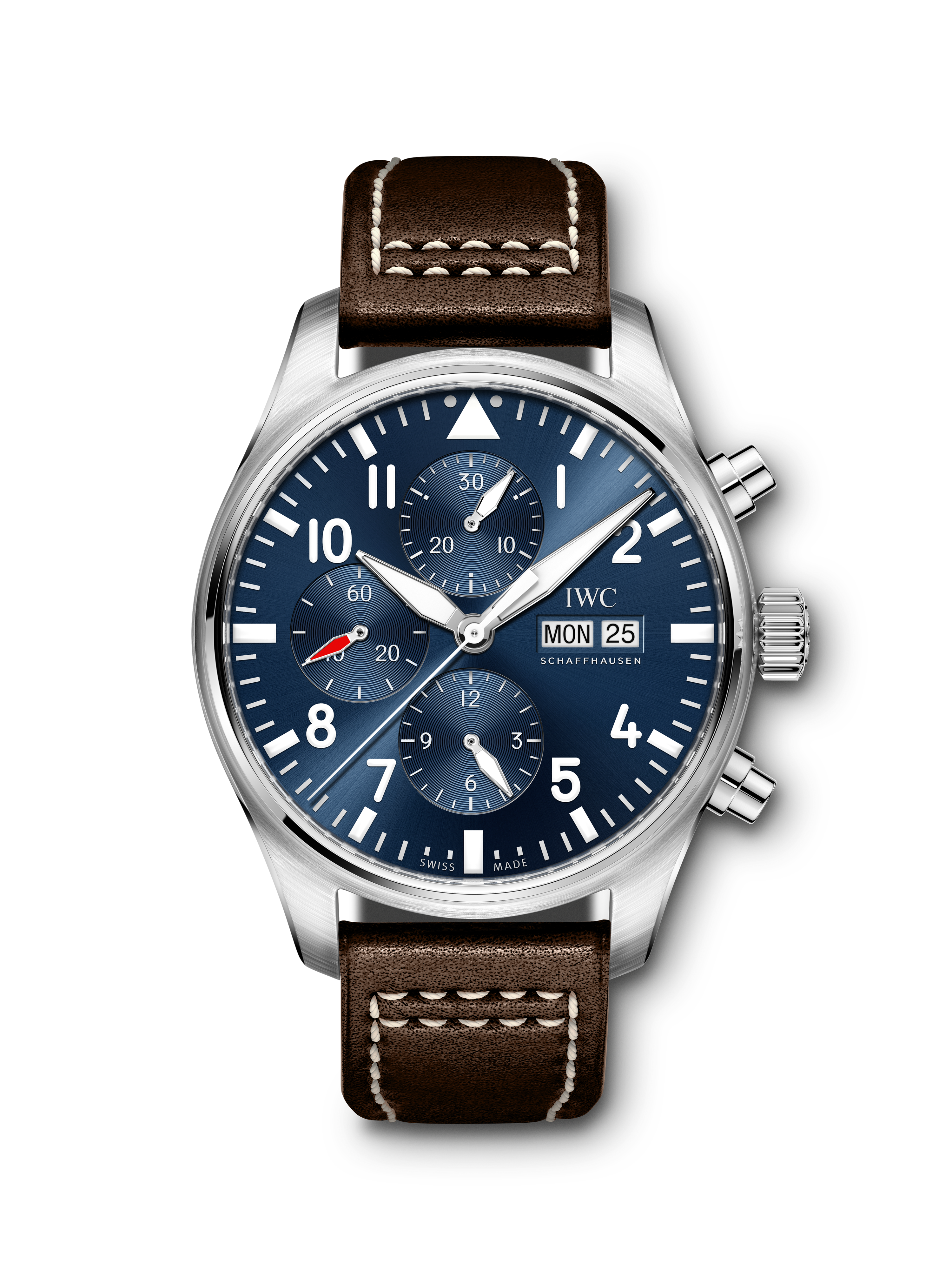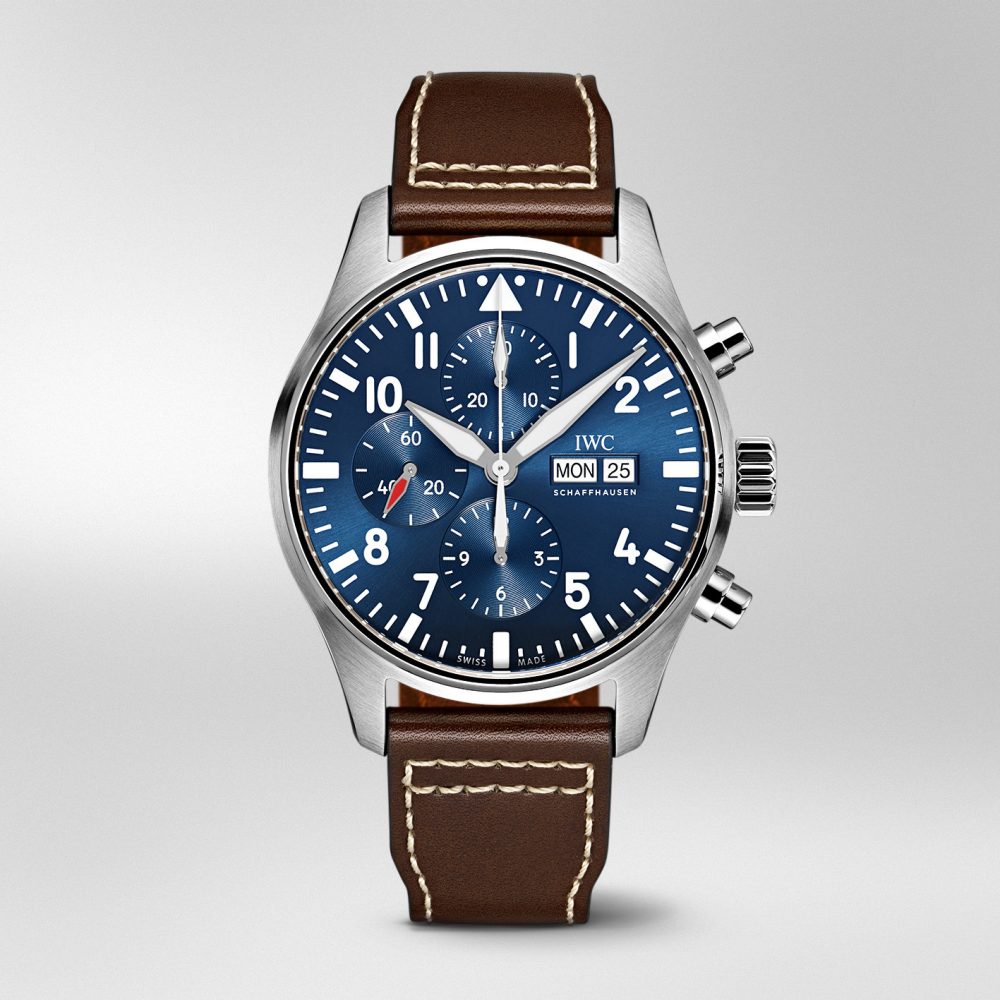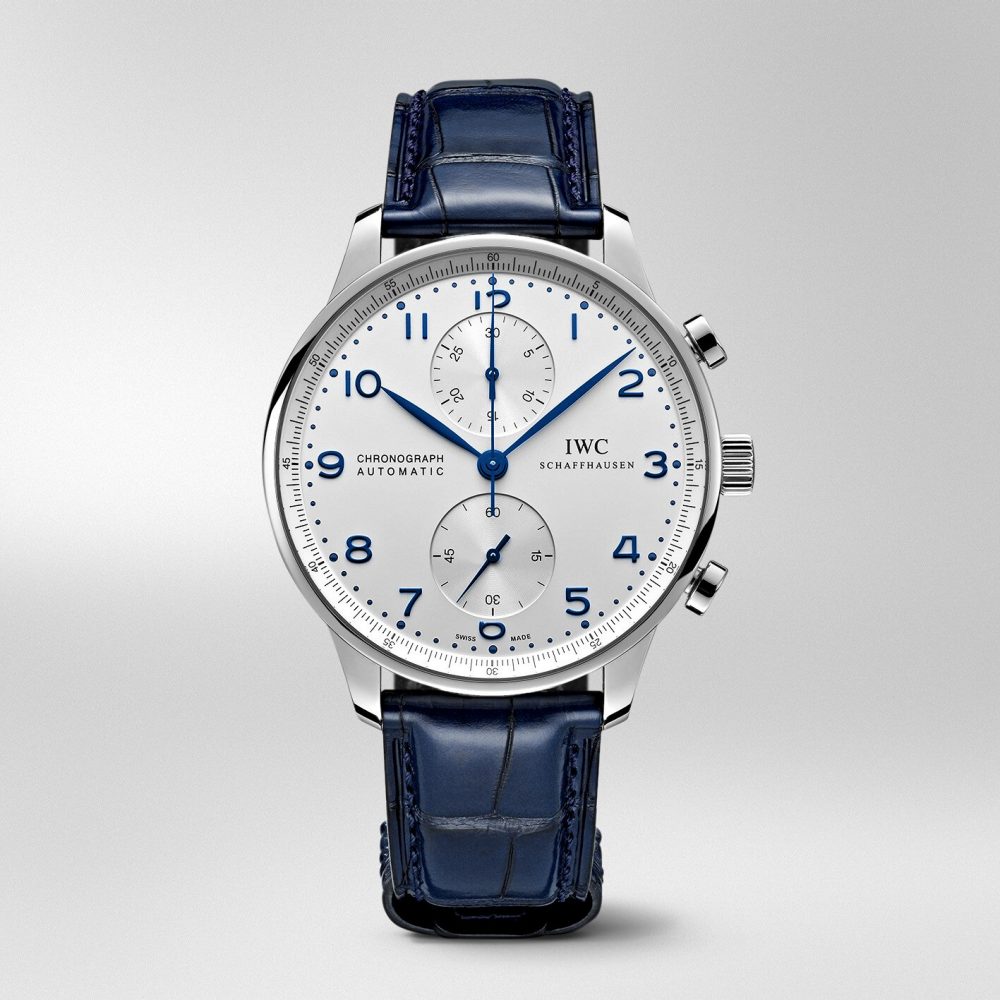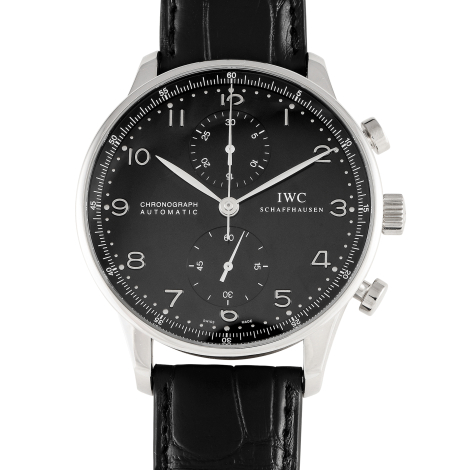Section 1 - History
An acronym for International Watch Company, IWC represents a sort of globalized brand, before global brands were a thing and a peculiar one at that.
The company was founded in 1868 by an American engineer and watchmaker named Florentine Ariosto Jones. His aim was to combine Swiss watchmaking precision with modern engineering and breakthroughs in mass-production, and then to export the final products to the USA.
At the time, Switzerland was a rather poor country, and people carried the watch trade in rather small, family-run labs.
Jones’ plan of opening a modern factory in the area was revolutionary. So much so, that it received firm opposition from the French-speaking community who lived in the traditional cradle of Swiss watch-making, forcing him to find another place to turn his dream into reality: Schaffhausen, in the German part of the country.

In 1875, his modern factory was finally built - a 45-meter long edifice that could accommodate 300 workers at a time.
But as far-sighted as Jones was, he was not a good administrator, and so in 1880 IWC was bought by Johann Rauschenbach.
His family owned IWC until 1955, managing the company with a very modern approach, where the welfare of the workers was a primary concern.
For example, after WWI, Ernest Jakob Homberger, the husband of one of the last Rauschenbach's, devoted himself to setting up social institutions. He improved the living quarters for the factory workers and established a fund for widows and orphans.
In 1929, the name of the fund was changed to the J. Rauschenbach Foundation and in 1949 he founded the Watch Company Welfare Foundation.
As a side note, the last heirs of the Rauschenbach family were two sisters. The first married Homberger while her sister married the famous psychologist Carl Gustav Jung, who for a time worked for IWC.
The last years of Rauschenbach's control over IWC saw the beginning of the turbulent era of the quartz.
The family did not have the economic power to make the kind of investments required to compete in this new market, so they sold the company to a German investment group. After some time, the company ended up in the LVMH group together with Jaeger Le Coultre and Lange and Sohne, and that group was finally acquired by Richemont.
Even if owned by a big behemoth, IWC still maintains its own peculiarities and fiercely independent spirit.
The official language of the company is German, and its business culture sets it apart from other typical Swiss watch companies.
The company was one of the first to maintain detailed records about every watch manufactured since 1855 and can provide access to them for a small fee.
Its technical department has expressed the specific commitment to maintaining and repairing every watch manufactured by IWC from its founding in 1868. Talk about “customer service”.
Unlike many other companies, IWC has always been open to new technologies.
During the quartz crisis, the company embraced the new industry trends and was one of the founders of the Centre Electronique Horloger which designed the Beta21 quartz movement - a quite successful one, as it powered some classics of the era like the Omega Electroquartz series and IWCs own Ingenieur, designed in that era by the famous Gerald Genta.
The company also has a long history of cooperation with Ferdinand Porsche, culminating in the launch of the Ocean 2,000, one of the first watches ever made in titanium.

Horologically speaking, over the years IWC has manufactured several calibers, including the famed Caliber 89, but also operated as an “etablisseur” in other product lines, using ETA or Sellita-supplied movements, and often, modifying them to create its own calibers in internal manufacturing lines developed from the end of the 1970s onwards.
Section 2 - Iconic pieces

The most important, and well-known, IWC model is the so-called “Little Prince”, the “Best pilots’ watch for non-pilots”, as the watch community calls it. The Little Prince collection is the company’s most important and is composed of an amazing number of references, ranging from simple three-handers to the most complicated chronographs and tourbillons.
Apart from the regular Little Prince, this collection includes a few special lines, like the Spitfire edition and the Top Gun edition
Another important watch for the company is the Ingenieur. This line was first released in 1955, one of the anti-magnetic models that were so popular back then. But in the mid-1970s, the Ingenieur was reinterpreted by Gerald Genta, who “refreshed” its look by applying the design elements of his particular style: a more fluid case, an important bezel with a porthole design, and an integrated bracelet.
The Aquatimer represents IWC’s approach to the diver’s watch and was introduced in the 1960s, after the boom of the Rolex Submariner, but it differs from the last through some interesting design choices, like the internal rotating bezel mounted under the glass which safely monitors dive times.
The Portuguese and the Portofino are IWC’s dress watches. The Portugueiser (German for Portuguese) derives its name from its initial buyers: two Portuguese businessmen who in the 1930s commissioned IWC to create a wristwatch to host the most precise pocket watch movement possible.
From these beginnings, the Portuguese collection increased in quantity, branching into other lines like the Portofino and the Da Vinci, and adding references and complications like chronographs, perpetual calendars, minute repeaters, and tourbillions to cater to a wide array of tastes.
1 - Little Prince Line

This collection of pilots watches derives from the original model launched in 1936, called "Spezialuhr für Flieger" ("Special Watch for Pilots").
That watch had a clean black dial, large hands, and luminous numerals. The 36 mm case was fairly large for the time, but pilots preferred an even larger dial and crown for extra visibility in the cockpit.
So, the company made a bigger model which debuted in 1940, the prototypical "Big Pilot's Watch", created for the German Air Force, which had a huge 55 mm diameter case, and was very rugged and visible.
The wristband was reinforced, and in later models, secured by metal studs, making it very sturdy. The crown was very big, so as to be used easily when wearing gloves. Also, there was an indicator on the rotating bezel, to allow the pilot to set a reminder for when to turn back home, as fuel was limited.
Over the years, this watch line assumed the popular name of the protagonist of Antoine de Saint-Exupery’s classic children’s book.
The Little Prince line features quintessential pilots’ watches ranging from 40mm to 55mm diameters, housing in-house or ebauche-derived calibers.
The Spitfire series has a more military-tuned vintage design and features in-house calibers with interesting complications.
The Top Gun series instead, has an ultramodern vibe that ties it more to fighter jets than to WWII airplanes.
2 - Ingenieur

The Ingenieur, as stated above, is IWC’s interpretation of the antimagnetic watch. It evolved from the roundish model of the 1960s, with its inner case made in soft iron to protect the movements from magnetic fields, to the Genta-inspired models, where he applied his design style to it, and then back to its roots, with the current reference 666 design inspired by the original 1960s look.
Apart from this iteration, the Ingenieur has met the world of motorsports, specifically with the intervention of AMG. The watch-maker has worked with innovative materials to render the Ingenieur a high-tech timepiece, introducing carbon, ceramic and titanium pieces into the design.
You can find many interesting complications in the Ingenieur line, from the most common, like the chronograph, to the most exotic, like perpetual calendars and tourbillons.
3 - Aquatimer line

The IWC Aquatimer line is composed of a vast array of references, offering choices of a beautiful diver’s watch with a twist. It came late to the niche but introduced elements that no other divers’ watch had, like the innovative internal bezel – IWC’s SafeDive system.
This system operated through the use of an additional crown to move the bezel, resulting in a safer experience for divers.
The original Aquatimer had a water resistance of 200 m (20 bar, 656 ft) that was increased to 300 m (30 bar, 984 ft) in later models, but there is also a deep-diving series that is certified water-resistant down to 2,000 m.
4 - Portuguese line

The iconic dress watch from IWC, the Portuguese is the company’s main “battleship”. The line's variety of references offers models for every style and price, from simple dress watch references to the most precious marvels in horology technique featuring complications such as chronographs and perpetual calendars, minute repeaters and star chart with tourbillon, which incorporate a constant-force system, for the ultimate Portugieser Siderale Scafusia.
The Portuguese models appeal to every watch lover who is looking for a dress watch.
The line comes available in every kind of metal, from stainless steel to various flavors of gold, all the way to platinum for the most exclusive, and expensive, references.
5 - Portofino line

The Portofino collection is sort of a more minimal version of the Portuguese, representing understated elegance in action. The dials are even cleaner than the Portuguese’s, and the whole impression of this line is one of perfect and timeless equilibrium.
The clean lines of the cases are exalted by the perfect finishing of the stainless steel and gold used. Some references also feature diamonds as accent pieces on cases and dials.
Despite the clean looks, the Portofino timepieces hide something very complex under the hood, as they include in-house movements and complications such as power reserve, moon phase, perpetual calendar, retrograde date, and tourbillons.
Section 3 - News

The next wave of expansion of the Schaffhausen-based brand? Forget China, and welcome America. This is the message from Chief Executive Officer Christoph Grainger-Herr.
“We spent the last 10 years building distribution in China, working it from infancy to where we are today,” Grainger-Herr said. “Now’s the time to go beyond Asia and Europe and focus on the US. If you do it right, it’s a very domestic market in the end and very loyal once you put in the initial investment.”
The time is ripe for a change from the Apple watch wearing crowd to something less ephemeral? “There is an audience that is more receptive to the message of a mechanical watch than before”.
The brand wants to add four retail outlets in 2019, with a focus on the East and West Coast as well as Texas and Atlanta and aims to more than double annual revenue in the country within five years, from the current $79 million.
To do that, the company added actor Bradley Cooper to its line of ambassadors and will extend its marketing and communications actions nation-wide, starting from the development of the first online shop launched in the country in 2017.
Section 4 - Gossip/Style

Jun 2019 - Tom Brady, the NFL superstar quarterback, is the latest IWC brand ambassador. With an outstanding record of six Super Bowls, four Super Bowl MVP titles, three NFL Player of the Year awards and 16 Division titles, Tom Brady is a symbol of excellence, and so, the perfect icon for IWC. His personal watch collection includes several IWC watches, including a Pilot's Watch Chronograph Top Gun Miramar and the iconic Portugieser Perpetual Calendar.

Apr 2016 - Zhou Xun, one of the most famous contemporary actors and singers in China, has been spotted wearing the IWC Portofino Automatic Moon Phase 37.
Chanel’s chief designer Karl Lagerfeld noted Zhou Xun for her strong fashion sense, describing the actress as "a synthesis of young Coco Chanel and Ballet Troupe Zizi Jeanmaire”.
Which from the late Kaiser Karl was one hell of a compliment.

Apr 2019 - Formula One driver Lewis Hamilton has proved himself a champion in another field as well - and we are talking about watch design. The British driver, who is an IWC ambassador, has been instrumental in the creation of a limited edition of the Ingenieur: his signature IWC Ingenieur Chronograph Lewis Hamilton Limited Edition. Which is very special, as it incorporates a piece of an actual Mercedes-AMG F1 W05 grand prix car in the case back of each watch. Each watch in this limited edition is accompanied by a certificate of authenticity attesting to IWC’s use of a true piece of the Mercedes-AMG “Silver Arrow” itself.
Section 5 – Current Most Popular Models
The most popular model from IWC is, without a doubt, the Little Prince.
The blue dial version is possibly the most diffused pilots’ watch worldwide, starting from the basic reference upwards to the most complicated ones.
The favorable price/performance ratio is also one of the key reasons why this watch is so popular.
The current development of the Little Prince, that is, the Spitfire line, is also quite popular in the watch crowd, thanks to its in-house movement and vintage looks, which closely follow the current watch trends.
Another very classy timepiece, the Portuguese is in high demand, especially in its chronograph version, as its timeless aesthetics, somewhat Bauhaus-inspired, find a big following between watch lovers, something that contributes to make this particular model one of the cornerstones of every watch collection.
The lovers of Genta as a designer are always keen for the Ingenieur he has designed in 1975: the watch was produced in only 1,000 pieces, something that makes it a pretty rare bird -so if you happen to find one, it has a high interest as for its investment value.
Section 6 – Current Approximate Price List By Line/Model
The Little Prince line
The current Little Prince line starts from the current entry model, the Mark XVIII, and proceeds to different versions and series. The line mounts a range of different calibers, from the outsourced (ETA and Sellita) to the in-house which equip every Big Pilot version. The materials used for the cases start from the classic stainless steel and arrive at the advanced components used in the Top Gun versions, like the titanium and ceramic.
The chronograph versions are also in high demand.
| Little Prince | |
| Type: | Sports Luxury Watch |
| Materials: | Stainless Steel, Gold, Bronze, Titanium, Ceramic |
| Functions: | Several depending on versions; most notable are chronograph, alarm, perpetual calendar |
| Price Range: |
The current “basic” Little Prince model, the Mark XVIII, is available for about $3,700 for the leather wristband version, while the steel bracelet versions arrive at $4,500. Earlier models cost a tad less, but the vintage ones which mounted a JLC movement are instead quite valuable, arriving at the $5,000 mark.
The current entry-level Spitfire models with a date are available at around $5,300 for the stainless steel version and $6,200 for the bronze one. The chronographs in this series start at around $7,500, and higher complications like the perpetual calendar or world timer can reach as high as $33,500. Earlier versions fare much lower, around $2,500 for the basic version and $3,500 for the chronograph, but are powered by ETA movements, not in-house calibers.
The Big Pilot, the direct heir of the original Fliegeruhr, costs $11,500, and if you want the gold version, this sum climbs up to $20,000. The Spitfire special edition which included a perpetual calendar and a moon phase display demands about $34,000.
As said, chronographs are common in the Little Prince line. The basic model, powered by a Sellita SW500, starts around $5,500. The Timezoner Chronograph is a world timer, and you can buy it for a tad less than $10,000. The Perpetual Calendar adds this complication to the basic chronograph, along with the moon phase indicator. It is available in rose gold limited edition and is available at about $37,500.
The Top Gun line features some innovative materials for the cases, mainly ceramic, which confer to this line a futuristic look and tuck inside them IWC’s in-house calibers: as you might suspect, all this technology at work has a price. Top Gun timepieces are available from the $7,000 mark for the three-hander upwards to around $10,000 for the chronograph. |
The Ingenieur line
The Ingenieur line represents a series of variations over what was essentially a tool watch which was designed by the watchmaker, re-designed by Gerald Genta, and lately, re-re-designed again in order to reach the vintage lovers crowd.
All along, the Ingenieur has been developed in several interesting models which have made it a cult watch for its followers.
| Ingenieur | |
| Type: | Sports Luxury Watch |
| Materials: | Stainless Steel, Gold, Carbon, Titanium, Ceramic |
| Functions: | Mainly date and chronograph, upwards to perpetual calendar and tourbillon |
| Price Range: |
The original Ingenieur was issued in two stainless versions, with and without date, which range from $7,000 upwards.
The Genta redesign, called Jumbo, is in very high demand and starts from around $15,000, but you might find the quartz-based version, the SL, at around $12,000. The Ingenieur 500,000 from 1989 has amazing resistance to magnetic fields thanks to its materials, and you might find it on the market for $9,500.
The newer Ingenieur AMG, developed together with the motorsports manufacturer, has cases in technical materials like titanium, ceramic and carbon. The first starts from around $3,900; the second, with its black case, from $8,600; and the last, with a carbon case and ceramic bezel, reaches $11,500. The chronographs, available in titanium cases, are available for around $8,500. |
The Aquatimer line
The Aquatimer range dates back to the 1960s, but has a timeless and very modern look, especially when considering some limited editions.
The internal bezel, which could be rotated with a crown, is the line’s signature feature, which has now been abandoned in the last editions. However, these watches still offer the same vintage charm they had before.
| Aquatimer | |
| Type: | Divers Watch |
| Materials: | Stainless Steel, Titanium, Ceramic |
| Functions: | Mainly date but also editions with chronograph and moon phase |
| Price Range: |
The basic Aquatimer costs about $4,500 with a rubber wristband, some $5,000 with a metal bracelet. Older references are available for around $1,000 less. The Aquatimer 2,000 is the version resisting to 2,000 meters, so it is a deep-diving watch, and is available for around $3,500 in stainless steel, while the earlier version in titanium, the Ocean 2,000, designed by Porsche, reaches the $5,500 mark.
Chronograph versions of the Aquatimer are available. They start around the $5,500 mark for the basic and reach $6,500 for the split-minute version. As above, adding a metal bracelet adds another $500 to the cost. |
The Portuguese line
The Portugieser is the main dress watch line of IWC and has a clean, understated design that echoes the suggestions of the German Bauhaus movement. The current collection of these timeless watches start from the most simple three-hander references and progresses up to chronographs to the most complicated timepieces which offer functions such as perpetual calendar, minute repeater, and stopwatch function, along with the tourbillon.
| Portuguese | |
| Type: | Dress Watch |
| Materials: | Stainless Steel, Gold, Platinum |
| Functions: | Every kind of function depending on the model |
| Price Range: |
The Portuguese start with the basic three-handers at around $4,500 for the stainless steel versions, rising up to $6,500 for the gold ones.
The chronograph versions are very popular, and retail for around $6,500 and $12,500, respectively.
The rattrapante version of the chronograph is available on several limited editions and starts from around $14,000.
The in-house caliber powered Portuguesers from the Classic series are more costly, selling for $9,500 for the stainless steel version and $16,500 for the gold version.
The automatic version with power reserve goes for around $9,000 for the stainless steel version and $14,500 for the gold version.
Special versions, like the Portuguese hand-wound Limited Edition released for the 125th anniversary, reach very interesting prices: from $9,500 for the stainless steel version to $17,000 for the gold version and $28,000 for the platinum version. The set released for the 150th anniversary, which includes a power reserve indicator, reach similar values.
The calendar versions are very much appreciated by watch enthusiasts.
The annual calendar models are available in stainless steel or gold, for $15,000 and $23,000, respectively.
The perpetual calendars of the watchmaker also fetch high prices: $27,000 for the gold version and $46,000 for the platinum one. The variety with the moon phase, available only in white and rose gold, hovers around the $30,000 mark. |
The Portofino line
IWC introduced the Portofino line in 1984, its name coming from the world-famous fishing town near Genoa, Italy, where the Italian high society used to spend the summer vacations. This is the inspiration for this collection: transmitting this allure coming from timeless sophistication and elegance.
| Portofino | |
| Type: | Dress Watch |
| Materials: | Gold, Platinum, Diamonds |
| Functions: | Every kind of complication depending on the model, chronograph, power reserve, perpetual calendar, moon phase, tourbillon |
| Price Range: |
The basic models of the Portofino line are the simple automatics, in stainless steel and gold, available for $3,500 and $8,500 respectively. The Portofino in stainless steel offers the option of a bracelet, at around $500 more.
The power reserve versions, in like materials, are available for $7,500 and $14,000, respectively.
The moon phase version includes the power reserve indicator as well, and fares for $9,800 and $15,800 respectively.
The perpetual calendar versions are vintage timepieces and are available starting from the $10,000 mark.
The Portofino line also offers chronograph timepieces, either in stainless steel or gold, based on aq Sellita movement, and they are available for $4,500 and $11,500, respectively.
The mono-pusher version, which includes a power reserve indication, is available in white or rose gold, and costs around $17,500. |
Section 7 – Previous Blog Post
4 Platinum Watches We Absolutely Love!
PLATINUM WATCHES FROM SOME OF OUR FAVORITE BRANDS INCLUDING AUDEMARS PIGUET, ROLEX, IWC AND CARTIER!
When it comes to status symbols, nothing says you have made it more than a platinum watch. Okay, maybe a platinum double tourbillon might be the pinnacle but you get what I am saying.
While the price of platinum, as a raw material, is only slightly higher than that of gold, it is still seen as the "best you can get". Read More...
Section 8 – Q & A
Are IWC watches of the same quality as Rolex watches?
It all boils down to your definition of “quality” - and more, your personal taste.
Because - let’s make a paragon here - which is better quality: an Audi SUV or a Lexus sedan? Those two are completely different cars, for completely different uses. Both are costly, prestigious, refined, with amazing quality and details, but two different cars altogether, which are bought (and esteemed) by two different kinds of public.
https://www.quora.com/Are-IWC-watches-of-the-same-quality-as-Rolex-watches
Do most people recognize IWC watches?
If people are going to recognize a watch it has to be “iconic” and in that respect when you are talking about people with no significant interest in watches they tend to recognize Rolex before any other.
IWC does not make iconic watches. Their most recognizable watches are those that are based on generic WW2 flight or pilot watches, or marine chronometers. The design is iconic but there are other companies that use the same design.
https://www.quora.com/Do-most-people-recognize-IWC-watches
What explains the price tag of an IWC Big Pilot?
The price tag of an IWC is explained by three reasons:
- It allows you to show that you CAN afford to purchase an IWC Big Pilot.
- It allows you to show that you have developed taste in watch collecting. Instead of stopping at the obvious, you started digging a little bit deeper than the usual suspects (Rolex or Patek).
- And last but not least, that price tag is the consequence of IWC looking at what level of quality they could invest in with the money that they were planning on charging. Could it have been manufactured in a cheaper way? Sure! And for that, there are brands such as Hamilton or Oris.
https://www.quora.com/What-explains-the-price-tag-of-an-IWC-Big-Pilot
What is the most iconic IWC watch of all time?
IWC has plenty of achievements none of which bring the term “iconic” to mind. If pressed, there are probably two candidates, the Portugieser, which is perhaps the most distinctive classic watch model around, and the Big Pilot, which is one of the quintessential pilot watches and extremely recognizable, partly by its big conical crown.
https://www.quora.com/What-is-the-most-iconic-IWC-watch-of-all-time
As an owner of an IWC, how often do people recognize your watch?
IWC, particularly the Pilot, is quite distinguishable if they know watches. For the common non-watch person, it’s hard for them to recognize what an IWC is because the markings are not that big. For those in the know though, it’s quite recognizable at least on my experience
https://www.quora.com/As-an-owner-of-an-IWC-how-often-do-people-recognize-your-watch


